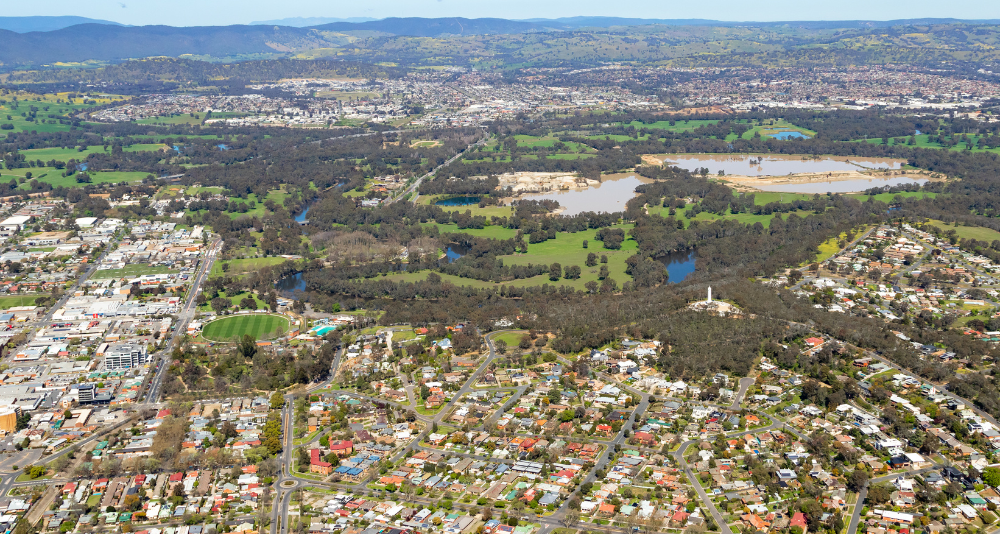
Source: AlburyWodonga.gov.au
Lytton Advisory recently visited Albury-Wodonga, and we have been thinking about some of the challenges of multi-level, multi-jurisdictional infrastructure planning.
Infrastructure Planning in Albury-Wodonga: Navigating Complexities and Embracing Opportunities
Albury-Wodonga, the iconic twin city on the Murray River border of New South Wales (NSW) and Victoria, exemplifies the complexities of infrastructure planning in border regions. As with other border areas, these cities grapple with intricate intergovernmental relations, but their unique geographical and administrative contexts add layers to the decision-making process. Both municipalities recognise this in their joint ‘Two Cities, One Community Approach’.
Key Challenges in Infrastructure Planning
- Harmonization of Standards and Regulations: Collaboration is a hallmark of infrastructure projects in this region. Yet, each state brings its unique set of standards, regulations, and bureaucratic processes. Reconciling these differences becomes pivotal. Without a synergistic approach, the twin cities could witness infrastructural discrepancies, leading to inefficiencies and possibly, public discontent.
- Interstate Transportation: Albury-Wodonga is not just two cities in proximity; it’s a transportation nexus. Roads, railways, and air links intertwine the destinies of these cities. The imperative is clear: both states must harmonize their efforts. Inconsistencies in funding allocation or project emphasis can stymie fluid connectivity, impeding the economic and social rhythm of the region.
- Resource Sharing and Management: Nature doesn’t recognize man-made boundaries. The Murray River, a lifeline for both cities, exemplifies shared natural resources. Consequently, infrastructure like water treatment plants or riverfront recreational areas require scrupulous planning. Both equitable access and the long-term ecological sustainability of these shared resources are at stake.
- Economic Development Consistency: Albury-Wodonga, in many ways, dreams of functioning as a cohesive economic hub. Yet, state-driven economic policies, if not aligned, can tilt the balance. For instance, preferential investment in one city’s industrial infrastructure could unintentionally dwarf the other’s economic aspirations.
- Community Engagement and Perception: Beyond bricks, mortar, and policy, lies the realm of human sentiment. Residents might oscillate between their state affiliations and a broader twin city identity. Their expectations, molded by these affiliations, play a pivotal role. Striking a balance in infrastructural development that resonates with these sentiments becomes paramount.
The Population-based Infrastructure Planning Dilemma
A proposition of tailoring infrastructure based on relative populations adds a layer of intrigue to the planning discourse.
Pros:
- At its core, population-based infrastructure seems egalitarian. Larger populations, logically, have augmented infrastructure needs. Meeting these proportionally ensures fairness.
- Such an approach can be agile, adapting to demographic dynamism and ever-evolving urban needs.
- Resource allocation rooted in population metrics could streamline funds, optimizing utility and curtailing wastage.
Cons:
- A myopic focus on numbers could eclipse nuanced needs. A smaller populace might harbor intense infrastructural demands due to myriad external factors.
- Over-emphasis on population-driven infrastructure could perpetuate developmental imbalances. One city, experiencing organic growth, might inadvertently overshadow its twin.
- Fragmentation is a lurking danger. The very essence of Albury-Wodonga lies in its intertwined identity. A skewed focus might fracture this cohesion.
Looking to the Future
As we gaze forward, it becomes abundantly clear that Albury-Wodonga’s tale is not merely about connecting two cities with roads and bridges. It’s an intricate dance of administrative alignment, resource optimization, and human aspirations. While the significance of population in infrastructural decision-making remains undeniable, it should meld with other considerations. The ambition should be holistic development, ensuring that both cities, while retaining their unique identities, march forward hand in hand, into a future replete with promise.
Harnessing collaborative synergies, championing sustainability, and placing residents at the heart of planning can ensure that Albury-Wodonga evolves from being two cities on a map to a pulsating, integrated urban entity.
Doing infrastructure planning in a tri-level, multi jurisdictional context has its challenges. Keen to hear about your experiences.
#InfrastructurePlanning #AlburyWodonga #UrbanDevelopment #TwinCities #StateCollaboration #RegionalGrowth #PopulationBasedFunding #CommunityEngagement #InterstateCollaboration #EconomicDevelopment